Working in a Sitting Position – Alternative Chairs Fact Sheets
WHY WOULD A PERSON USE AN ALTERNATIVE STYLE OF CHAIR?
For some people, using an alternative chair helps them to maintain appropriate posture.
Posture is the alignment of the body’s head, trunk, and limbs. An active posture requires the coordinated action of many muscles and structures within the body. Active postures can be either static or dynamic. A static posture occurs when we maintain one alignment for a prolonged period of time. Examples include standing, sitting, or kneeling. Dynamic postures refer to body alignments that occur when the body and/or limbs are moving such as walking, jumping, or running.
Generally speaking, a good posture is one in which the head, trunk, and limbs are in a state of balance that protects the body against injury or deformity. Poor posture occurs when body produces increased strain on the supporting structures, and decreased balance over the base of support.
While posture is related to many factors, some people may find that maintaining posture can be helped by using an alternative chair. There is no one single chair that can be recommended. Users should consider:
- How the chair helps or hinders their natural posture.
- Presence or absence of pressure points.
- Ability to change positions easily.
- Ability to do the tasks required while sitting.
What are examples of “alternative” chairs?
The forward sloping chair and the kneeling chair are alternatives for workers who sit continuously. A saddle chair (sit-stand seat) allows a worker to alternate between sitting and standing.
What is a forward sloping chair?
A forward sloping chair has a mechanism that allows the user to adjust the tilt of the seat pan forward. The angle of tilt from the horizontal should not be greater than 10 degrees.
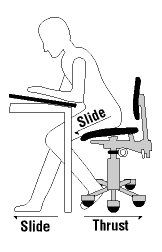
What are some advantages of a forward sloping chair?
The use of a forward sloping chair:
- Increases the number of possible positions.
- Can provide better alignment for the spine and/or reduce the muscular load on the back.
- Improves visual distance and angle to the task on a worktable.
- Improves head position.
- Improves return blood flow from the lower legs, provided that the effort is more dynamic than static load on the muscles.
- Decreases pressure on internal organs.
What are some disadvantages of a forward sloping chair?
The use of a forward sloping chair:
- Places more weight on legs to control forward tilt of the upper body, and may result in earlier development of tiredness.
- May cause the body to slide forward; however, if the seat pan of such a chair is curved from front to back, it would allow you to sit without sliding. Nevertheless, you do have do exert some muscular effort in your lower legs to remain seated. This effort may be beneficial (providing the slope is not greater than 15 degrees) if it improves the return blood flow from your lower legs.
- May cause clothing to ride up the legs.
- May require the work station to be adjusted to accommodate the position (e.g., surface height, monitor height, etc.).
What is a kneeling chair?
A kneeling chair has a fixed seat sloping at 30 degrees forward and padded support for knees. It does not have a back rest. A kneeling chair places the user in a modified kneeling position.
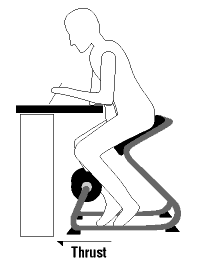
What are some advantages of a kneeling chair?
A kneeling chair:
- Provides alignment for the spine and/or reduce the load on the lower back.
- Can make forward-reaching easier.
What are some disadvantages of a kneeling chair?
A kneeling chair:
- Should be fitted to the individual.
- Causes shins to bear weight.
- Over-flexes knees and ankles.
- May cause static load on muscles.
- Limits the number of possible sitting positions.
- May cause fatigue to develop earlier.
- May cause clothing to ride up legs.
- Makes getting in and out of the chair difficult.
- May force the individual to lean forward on the work surface, thereby applying pressure on wrists, arms and elbows.
- Reduces the range of reaches.
- Makes side reaches more difficult since most kneeling chairs do not swivel.
- May require adjustments to the workstation.
When would you use a saddle chair or a sit-stand seat?
Saddle chairs have a different style of seat, one similar to a saddle used by horseback riders. It often has a wider seat that encourages the legs to splay outwards.
A saddle chair may:
- Reduce fatigue by decreasing muscular effort.
- Improve alignment of the spine.
- Allow legs to drop more naturally and widen the stance.
A common cited disadvantage of a saddle chair include that raised parts of the seat may place pressure on the genital area.
Are there some other things I should know about alternative seating?
Sit/stand rests or chairs and sitting/kneeling support could be made available in certain situations.
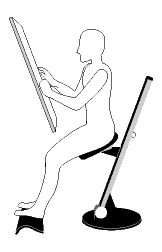
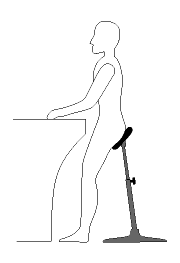
Rest Chair
It is desirable to have a chair for resting even when work can only be done standing. If space is limited, then a chair that can be folded up and stored out of the way can be used.
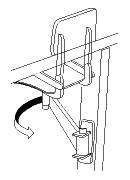
Sitting/Kneeling Support
Making hip support available where the work requires kneeling:
- Reduces tension in the thigh muscles, by widening the angle of the knees.
- Reduces compression on the knees, ankles and lumbar region (middle to lower back).
- Improves blood circulation.
.gif)
- Do not maintain kneeling/sitting position for extended periods.
- Avoid bending.
- Stand up and walk whenever possible.
.gif)
What are the advantages and disadvantages of using fitness or exercise balls as seating?
Fitness (also known as exercise, therapy, or stability) balls have been used by some people as an alternative chair. The ball must be of the right strength, size, and quality to support the person using it. If recommended by a health care professional, the program should include recommendations such as how long to use the ball per day, how many days, and other accommodations.
Advantages include:
- May encourage dynamic posture; however, studies are inconclusive.
Disadvantages include:
- High concentration required to maintain posture.
- Possibility of muscle fatigue while sitting.
- Lack of arm rests and back support.
- Tasks involving reaching, swiveling or moving are more difficult.
- Risk of falling when getting on and off the ball.
- The ball is unstable.
- The surface of the ball may not provide adequate support for the buttock and thighs.
- The workstation may need to be readjusted.
Source: © Copyright 1997-2021 CCOHS